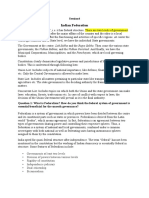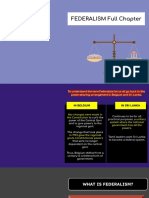Federalism is a system of government in which power is divided between a central authority and
various state governments. In this system, both the centre and the states are independent in their
spheres of work. This ensures that power is not concentrated in one authority and that regional
needs are respected while maintaining unity at the national level.
The main features of federalism include two or more levels of government, a clear division of powers
given by the Constitution, the presence of a written Constitution, an independent judiciary to settle
disputes, and separate sources of revenue for each level of government.
There are two kinds of federations. In a “coming together” federation like the USA, Switzerland, or
Australia, independent states come together voluntarily to form a bigger nation, retaining their
identity while pooling sovereignty. In a “holding together” federation like India, Belgium, or Spain, a
large country divides power between the centre and states to keep the nation united.
India is a holding together federation with three levels of government – Union, State, and Local. The
Constitution divides subjects into Union List (like defence, foreign affairs, currency), State List (like
police, agriculture, trade), and Concurrent List (like education, marriage, forests). Residuary powers,
or subjects not mentioned in the Constitution, go to the Union government.
India has also promoted unity by reorganising states on a linguistic basis after 1956. The language
policy is flexible – India has no national language, though Hindi and English are official languages, and
each state can have its own official language.
To strengthen democracy, the 73rd and 74th Constitutional Amendments introduced Panchayati Raj
for rural areas and Municipalities for urban areas. This decentralisation brought power to the local
level. Thus, Indian federalism balances unity with diversity, prevents misuse of power, and ensures
government is closer to the people.

























































